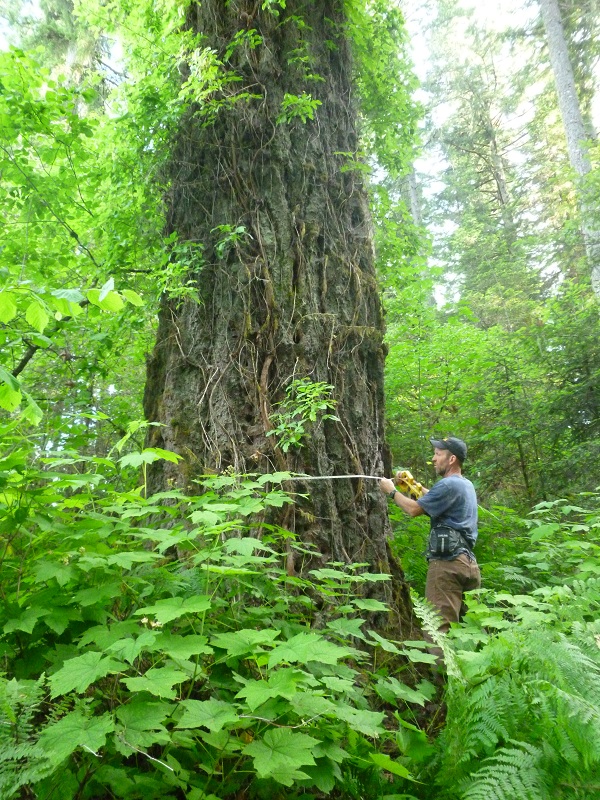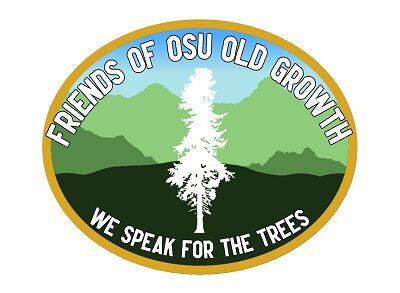The first step to getting involved is taking a few minutes to understand what’s going on. We’ve tried to provide some background info. and ideas for engagement below. You can also check out our “Learn More” page for more info. If you have questions after reading this page or ideas to share, please let us know at: friendsofosuoldgrowth@gmail.com
Jayathi Murthy became OSU’s 16th president on Sept. 9th, 2022. Soon after she joined OSU, I (and leaders of a number of local conservation groups) reached out to president Murthy requesting an introductory meeting. Unfortunately, despite many requests, she has been unwilling to meet with any of us. What does it say when the president of our public university promotes her engagement efforts with a diversity of groups – but won’t meet with conservation leaders? More about this in a future blog piece…
OSU Leaders Refuse to Respond to Questions about Biased Forest Planning Process: For more than a year, we’ve been asking the dean of the College of Forestry (Tom DeLuca), associate dean (Holly Ober), president Murthy, and the OSU Trustees important questions about their current forest planning process for the McDonald-Dunn “research forests” – yet they won’t even acknowledge our questions!
As detailed in past blog pieces (OSU’s Forest Planning – More Broken Promises, and Traditional vs. Collaborative: How OSU Leaders are Violating their Collaborative Commitment to Forest Planning), OSU leaders have consistently violated not only promises regarding forest planning, but also key provisions of Oregon law (which state they shall provide transparency and public accountability), OSU’s core values (which call for honest and open communications), and their own bylaws (how does clearcutting forests equate to “preserving and protecting the university’s assets for posterity”?!).
There has never been a better time to influence how OSU operates when it comes to “leadership in forestry education” and the stewardship of the “research forests”. OSU is a public university and the College’s forests are a public resource (the property titles are held by the State of Oregon). These lands must be stewarded to provide vital, natural forests that provide wildlife habitat, clean air and water, and protect us from climate change and wildfires (did you know that old-growth forests are naturally resistant to wildfires?). Together, we must hold OSU’s leaders accountable!
If you’d like to get involved, here are some specific things to do and keep in mind:
Holding OSU’s leaders accountable with compelling and persistent emails is one of the best ways to affect change. Grab hold of an issue, do some research, contact the individuals in charge – and don’t let go!
(if you’re willing to CC or BCC friendsofosuoldgrowth@gmail.com, it will help us monitor issues of concern – all personal information will be kept strictly confidential).
***********************************************************************
Here are some specific things to advocate for and do to improve OSU’s stewardship of the McDonald-Dunn Forest:
Protect All Remaining Stands of Mature Forest (and STOP clearcutting!): The previous (Interim) dean placed a temporary moratorium on the cutting of all trees 160 years of age and older. While a step in the right direction, this was also long overdue. Whether or not this moratorium becomes permanent will depend on the current dean and the next forest plan. In recent years, OSU’s forest managers have routinely cut stands of trees ranging from 70 to over 120 years of age (and without doing the carbon accounting called for in the 2005 management plan). Why is OSU cutting trees that are 2-3 times older than the industry average? These ecologically-important older stands should NOT be cut, period! Unfortunately, the majority of OSU’s “harvests” are still essentially clearcuts. The College should be leading the way in demonstrating ecological forestry with ALL of their forest management activities. The dean and his staff should be prioritizing ecology and carbon sequestration, not timber production!
We’d like to see ALL sections of mature forest on OSU lands permanently set aside for carbon storage, wildlife and ecological research, and educational purposes. The term Late Successional Forests in the Pacific Northwest refers to forests that are >80 years in age. These stands are important habitat for northern spotted owls and are the precursors of future old-growth forests. The federal government has largely stopped cutting Late Successional Forests (i.e. trees > 80 years old) – so ask dean DeLuca and his forest managers to conform to the same (80-year) protection standard. The College’s 2021 “Harvest Plan” targeted older stands (many falling under the Late Successional classification).
Follow the 2005 Plan for the McDonald-Dunn: On October 21st of 2019, Interim Dean, Anthony Davis, made a formal “un-suspension” of the 2005 Research Forest Plan stating that the 2005 Plan would remain in effect until the next plan is finalized (in approx. 3 years’ time). In the meantime, we need to make sure the managers of the Research Forests follow the 2005 plan “to a T”.
Some key things to think about and look for when you’re hiking in the forest:
- More than a dozen large harvests in the southern zone of the McDonald Forest from the past couple of years violated the plan’s 1-4 acre limit. We need to make sure ALL cuts in the southern zone of the McDonald Forest follow the 1-4 acre proscription! You can find details of OSU’s current logging activities here: https://cf.forestry.oregonstate.edu/harvest-webmap If you see something of concern, please let us know (email: friendsofosuoldgrowth@gmail.com)
- Harvests in the southern zone of McDonald Forest have reduced nesting/roosting/foraging (NRF) habitat for threatened northern spotted owls by ~166 acres (more than 10% of the original 1,585 acres) – in direct violation of the 2005 Plan. We need to make sure all future harvests are in compliance with the Plan and do not diminish NRF habitat for northern spotted owls. Determining NRF can be a little tricky, but it is safe to say cuts of old forest in the southern zone of the McDonald Forest either violate or fragment the existing NRF habitat. Ask dean DeLuca to restore the 166 acres of NRF habitat destroyed in the past by setting aside other sections of mature forest. OSU’s forest managers continue to cut substantial sections of older forest that could have become future owl habitat. It is not enough to simply protect the diminished NRF habitat. The College should be leading the effort to increase northern spotted owl habitat by demonstrating how to do it in the Mac-Dunn!
- The 2005 Research Forest Plan called for a review of key sustainability indicators (including “Estimates of carbon balance completed for each land allocation and management unit. (Five year report)” and “Distribution, quantity, and characteristics of legacy structures and character trees. (Leave tree database by harvest unit compared to plan guidelines)” among many other factors). Ask the Dean and his staff to evaluate and publish these sustainability indicators for all current and future harvests. We would especially like to see them keep their commitment to measure carbon impacts of their logging. A 2018 study by OSU researchers found that logging is by far the largest source of greenhouse gas emissions in Oregon (https://sustainable-economy.org/osu-research-confirms-big-timber-leading-source-greenhouse-gas-emissions-oregon/)
Submit a “Letter to the Editor” at the Gazette Times, The Oregonian, or other publication: https://www.gazettetimes.com/forms/contact/letter_to_the_editor/ https://www.oregonlive.com/opinion/page/how_do_i_write_a_letter_to_the.html
Make it a personal and powerful message. Share your views on how OSU should be demonstrating “leadership in forestry education“. Remind folks that OSU is a public institution that ought to be stewarding these public lands to meet public expectations and needs. Urge the dean to change management priorities to reflect the purpose of the forests: REASEARCH (without a timber bias). Carbon sequestration, wildlife, and ecology must take precedence over revenue generation!
Change the Management Structure of the Research Forests: Contact the dean of the College of Forestry, OSU President, and Board of Trustees to let them know these issues are important to you. Ask that they prioritize carbon sequestration, wildlife habitat, and ecological research in the research forests by changing the management of the forests to a multi-college administrative body (for more details, visit: https://www.facebook.com/McDDFuture/ or https://tlc5103.wixsite.com/mcddfuture ) The current Director of the “Research Forests” (Stephen Fitzgerald) has a long history of pro-timber bias. He oversaw the cutting of old growth in 2019 and should be replaced.
Remind OSU’s leaders that cutting old growth does not align with their mission, goals, and core values (see: https://leadership.oregonstate.edu/trustees/oregon-state-university-mission-statement) or their bylaws (which require them to preserve and protect the university’s assets for posterity). Tell them OSU’s research forests should be dedicated to research, not used to promote destructive industrial forestry practices like clearcutting. Ask them to restrict timber industry funding of the dean’s position (his salary comes from a $5 million endowment from the past president and CEO of Roseburg Forest Products). Leaders of our public university should not be bought by private industry! Let president Murthy and the trustees know you expect positive change – and intend to hold them accountable for it!
Contact the Oregon Department of State Lands (DSL) to express your concern about the deeply-flawed public process and OSU’s timber-centric, scientifically-invalid “research” plan for the Elliott State Forest: https://www.oregon.gov/DSL/Pages/Comment.aspx
Even though OSU is no longer seeking to own the Elliott directly, their “research” and management plans will be used to solidify their “working forests” agenda for the Elliott. For more info., read our blog piece, “The OSU-Elliott Problem”: https://friendsofosuoldgrowth.org/2019/12/13/the-osu-elliott-problem/
Contact your local Oregon representatives (e.g. Senator Sara Gelser Blouin and Representative Dan Rayfield) to let them know you care about forestry issues and the OSU Research Forests. With OSU in their district, they can choose to play a leading role in encouraging OSU to reform their antiquated forestry management practices.
Get Involved in the Forest: We’re looking for people who can help with the following activities:
- GPS Mapping of remnant stands of old trees (we need experts in GPS technology as well as volunteers to help with mapping and measuring)
- Adopt a Grove / Harvest Area: If you like to get out in the forest (or clearcuts), we could use your help assessing whether OSU is following their management plan and the commitment to stop cutting all trees over 160 years old. Tasks might include taking photos and measurements of old trees and stumps, and marking them. We can provide guidance and measurement tools.
- Assessing and documenting past and future harvests: If you like to explore the forests and take photos, we could use your help ground-truthing the College’s forest management activities.

Thanks for your continued support!
Doug (& Friends of OSU Old Growth)
